Acetylcholinesterase inhibitors for autistic spectrum disorders
- PMID: 37267443
- PMCID: PMC10233795
- DOI: 10.1002/14651858.CD013851.pub2
Acetylcholinesterase inhibitors for autistic spectrum disorders
Abstract
Background: Autism spectrum disorder (autism) is a neurodevelopmental condition characterised by impairments in social communication and interaction, plus restricted, repetitive patterns of behaviour and interests. Whilst some people embrace autism as part of their identity, others struggle with their difficulties, and some seek treatment. There are no current interventions that result in complete reduction of autism features. Acetylcholine is a neurotransmitter for the cholinergic system and has a role in attention, novelty seeking, and memory. Low levels of acetylcholine have been investigated as a potential contributor to autism symptomatology. Donepezil, galantamine, and rivastigmine (commonly referred to as acetylcholinesterase inhibitors) all inhibit acetylcholinesterase, and have slightly different modes of action and biological availability, so their effectiveness and side-effect profiles may vary. The effect of various acetylcholinesterase inhibitor on core autism features across the lifespan, and possible adverse effects, have not been thoroughly investigated.
Objectives: To evaluate the efficacy and harms of acetylcholinesterase inhibitors for people with the core features (social interaction, communication, and restrictive and repetitive behaviours) of autism. To assess the effects of acetylcholinesterase inhibitors on non-core features of autism.
Search methods: In November 2022, we searched CENTRAL, MEDLINE, Embase, eight other databases, and two trials registers. We also searched the reference lists of included studies and relevant reviews, and contacted authors of relevant studies.
Selection criteria: Randomised controlled trials (RCTs), comparing acetylcholinesterase inhibitors (e.g. galantamine, donepezil, or rivastigmine) of varying doses, delivered orally or via transdermal patch, either as monotherapy or adjunct therapy, with placebo. People of any age, with a clinical diagnosis of autism were eligible for inclusion.
Data collection and analysis: We used standard methodological procedures expected by Cochrane. Our primary outcomes were core features of autism and adverse effects. Secondary outcomes were language, irritability, hyperactivity, and general health and function. We used GRADE to assess certainty of evidence.
Main results: We included two RCTs (74 participants). One study was conducted in Iran, the second in the USA, although exact location in the USA is unclear. Galantamine plus risperidone versus placebo plus risperidone One study compared the effects of galantamine plus risperidone to placebo plus risperidone (40 participants, aged 4 years to 12 years). Primary and secondary outcomes of interest were measured postintervention, using subscales of the Aberrant Behavior Checklist (score 0 to 3; higher scores = greater impairment). Very low-certainty evidence showed there was little to no difference between the two groups postintervention for social communication (mean difference (MD) -2.75, 95% confidence interval (CI) -5.88 to 0.38), and restricted and repetitive behaviour (MD -0.55, 95% CI -3.47 to 2.37). Overall autism features were not assessed. Adverse events may be higher in the galantamine plus risperidone group (75%) compared with the placebo plus risperidone group (35%): odds ratio 5.57, 95% CI 1.42 to 21.86, low-certainty evidence. No serious adverse events were reported. Low-certainty evidence showed a small difference in irritability (MD -3.50, 95% CI -6.39 to -0.61), with the galantamine plus risperidone group showing a greater decline on the irritability subscale than the placebo group postintervention. There was no evidence of a difference between the groups in hyperactivity postintervention (MD -5.20, 95% CI -10.51 to 0.11). General health and function were not assessed. Donepezil versus placebo One study compared donepezil to placebo (34 participants aged 8 years to 17 years). Primary outcomes of interest were measured postintervention, using subscales of the Modified Version of The Real Life Rating Scale (scored 0 to 3; higher scores = greater impairment). Very low-certainty evidence showed no evidence of group differences immediately postintervention in overall autism features (MD 0.07, 95% CI -0.19 to 0.33), or in the autism symptom domains of social communication (MD -0.02, 95% CI -0.34 to 0.30), and restricted and repetitive behaviours (MD 0.04, 95% CI -0.27 to 0.35). Significant adverse events leading to study withdrawal in at least one participant was implied in the data analysis section, but not explicitly reported. The evidence is very uncertain about the effect of donepezil, compared to placebo, on the secondary outcomes of interest, including irritability (MD 1.08, 95% CI -0.41 to 2.57), hyperactivity (MD 2.60, 95% CI 0.50 to 4.70), and general health and function (MD 0.03, 95% CI -0.48 to 0.54) postintervention. Across all analyses within this comparison, we judged the evidence to be very low-certainty due to high risk of bias, and very serious imprecision (results based on one small study with wide confidence intervals). The study narratively reported adverse events for the study as a whole, rather than by treatment group.
Authors' conclusions: Evidence about the effectiveness of acetylcholinesterase inhibitors as a medication to improve outcomes for autistic adults is lacking, and for autistic children is very uncertain. There is a need for more evidence of improvement in outcomes of relevance to clinical care, autistic people, and their families. There are a number of ongoing studies involving acetylcholinesterase inhibitors, and future updates of this review may add to the current evidence.
Trial registration: ClinicalTrials.gov NCT01098383 NCT01887132 NCT00252603.
Copyright © 2023 The Cochrane Collaboration. Published by John Wiley & Sons, Ltd.
Conflict of interest statement
Alexandra Ure (AU) is a Senior Psychologist with Monash Children's Hospital, where she is involved in child developmental assessments and the supervision of staff and students. She is also a Senior Research Fellow with Monash University, with an interest in complex neurodevelopmental disorders, including autism spectrum disorder. AU declares a Clinical Sciences Fellowship from Monash University for her work to embed research into new clinical service, involving assessments of children presenting with neurodevelopmental concerns and their families; paid to Monash University.
Georgina Cox (GC) is an Editor with Cochrane Developmental, Psychosocial and Learning Problems (DPLP) and Cochrane Common Mental Disorders. GC was not involved in the editorial process for this review.
Richard Haslam is the Director of Mental Health at the Royal Children's Hospital, Melbourne (salaried position). He has declared that he has no conflicts of interest.
Katrina Williams (KW) reports a grant from the National Health and Medical Research Council (NHMRC) for a phase III trial of cannabidiol for severe behaviour disorders in children with an intellectual disability, with or without autism, on which she is Chief Investigator (1 January 2020 to 31 May 2023); paid to institution, but KW benefited from this payment, or had access to the funds. KW also reports contracts with Epsilon Healthcare (formerly THC Global Group Ltd; ongoing since 1 January 2020), to develop an interventional product and placebo for children, which is being provided by the Victorian Government for a Medical Research Future Fund funded phase III multisite trial; and with Tilray (from 28 November 2018 to 27 November 2019) for the investigation drug and placebo for a pilot trial of cannabidiol for severe behaviour problems in children with intellectual disability, with or without autism; both paid to the institution. KW reports a grant from the NHMRC for an ongoing prognosis study about predictors of autism outcome, which will also publish diagnostic stability outcomes, and which could be included in an update of this systematic review; paid to the institution. Lastly, KW reports that she is an Editor with DPLP; however, she was not involved in the editorial process for this review.
Figures

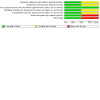
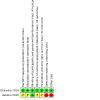



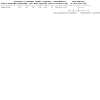


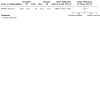

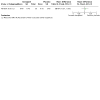
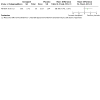
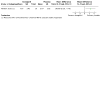

Update of
- doi: 10.1002/14651858.CD013851
References
References to studies included in this review
Ghaleiha 2014 {published data only}IRCT201204081556N40
-
- Ghaleiha A, Ghyasvand M, Mohammadi M-R, Farokhnia M, Yadegari N, Tabrizi M, et al. Galantamine efficacy and tolerability as an augmentative therapy in autistic children: a randomized, double-blind, placebo-controlled trial. Journal of Psychopharmacology 2014;28(7):677-85. [DOI: 10.1177/0269881113508830] - DOI - PubMed
-
- IRCT201204081556N40. Galantamine in the treatment of autism [Galantamine added to risperidone in the treatment of autism: a double blind and placebo controlled trial]. en.irct.ir/trial/890?revision=890 (first received 14 April 2012).
Handen 2010 {published data only}
-
- Handen BL, Johnson CR, McAuliffe-Bellin S, Murray PJ, Hardan AY. Safety and efficacy of donepezil in children and adolescents with autism: neuropsychological measures. Journal of Child & Adolescent Psychopharmacology 2011;21(1):43-50. [DOI: 10.1089/cap.2010.0024] [PMCID: PMC3037196] [PMID: ] - DOI - PMC - PubMed
-
- Hardan AY, Johnson C, Handen BL. 161. Preliminary findings from a double-blind placebo-controlled study of donepezil in pervasive developmental disorders. Biological Psychiatry 2006;59(Suppl 8):50S. [DOI: 10.1016/j.biopsych.2006.03.005] - DOI
-
- NCT00047697. Donepezil HCl & cognitive deficits in autism [Donepezil HCl: treating cognitive deficits in autism]. clinicaltrials.gov/show/NCT00047697 (first received 11 October 2002).
References to studies excluded from this review
Arnold 2012 {published data only}
-
- Arnold LE, Aman MG, Hollway J, Hurt E, Bates B, Li X, et al. Placebo-controlled pilot trial of mecamylamine for treatment of autism spectrum disorders. Journal of Child and Adolescent Psychopharmacology 2012;22(3):198-205. [DOI: 10.1089/cap.2011.0056] [PMCID: PMC3417385] [PMID: ] - DOI - PMC - PubMed
Chez 2003 {published data only}
-
- Chez MG, Buchanan TM, Becker M, Kessler J, Aimonovitch MC, Mrazek SR. Donepezil hydrochloride: a double-blind study in autistic children. Journal of Pediatric Neurology 2003;1(2):83-8. [DOI: 10.1055/s-0035-1557175] [URL: tinyurl.com/694xrxmv] - DOI
-
- Chez MG, Tremb RJ, Nowinski CV, Field-Chez M. Double-blinded placebo-controlled aricept study in children with autistic spectrum disorder. Annals of Neurology 2001;50(Suppl 3):S60-1. [DOI: 10.1002/ana.1189] - DOI
Gabis 2019 {published data only}
-
- NCT01098383. Treatment with acetyl-choline esterase inhibitors in children with autism spectrum disorders [Treatment with acetyl-choline esterase inhibitors in children with autism]. clinicaltrials.gov/show/NCT01098383 (first received 11 March 2010).
NCT01887132 {published data only}
-
- NCT01887132. A trial of the drug donepezil for sleep enhancement and behavioral change in children with autism [A randomized controlled trial of donepezil for REM enhancement and behavioral change in autism]. clinicaltrials.gov/ct2/show/NCT01887132 (first received 22 June 2013).
Sahu 2013 {published data only}
References to studies awaiting assessment
References to ongoing studies
IRCT2017041333406N1 {published data only}IRCT2017041333406N1
-
- IRCT2017041333406N1. The efficacy of augmentation donepezil to risperidon in treatment of autism spectrum disorders [Assessment the efficacy of augmentation donepezil to risperidon in treatment of autism spectrum disorders]. en.irct.ir/trial/25769 (first received 20 September 2017).
NCT00252603 {published data only}
-
- NCT00252603. Galantamine versus placebo in childhood autism. clinicaltrials.gov/ct2/show/NCT00252603 (first received 9 November 2005).
Rahman 2018 {published data only}
-
- Rahman A, Freedman R, Hollander E. S59. Alpha-7 nicotinic acetylcholine receptor positive allosteric modulator galantamine in autism spectrum disorder. Biological Psychiatry 2018;83(Suppl 9):S369‐70. [DOI: 10.1016/j.biopsych.2018.02.950] - DOI
Additional references
Achenbach 2001
-
- Achenbach TM, Rescorla LA. Manual for the ASEBA School-Age Forms & Profiles: An Integrated System of Multi-informant Assessment. Burlington, VT: University of Vermont, Research Center for Children, Youth & Families, 2001.
Aman 1986
-
- Aman MG, Singh NN. Aberrant Behavior Checklist: Manual. East Aurora (NY): Slosson Educational Publications, 1986.
APA 1980
-
- American Psychiatric Association. Diagnostic and Statistical Manual of Mental Disorders (DSM-III). 3rd edition. Arlington, VA: American Psychiatric Association, 1980.
APA 1987
-
- American Psychiatric Association. Diagnostic and Statistical Manual of Mental Disorders (DSM-III-R). 3rd Revision edition. Arlington, VA: American Psychiatric Association, 1987.
APA 1994
-
- American Psychiatric Association. Diagnostic and Statistical Manual of Mental Disorders (DSM-IV). 4th edition. Arlington, VA: American Psychiatric Association, 1994.
APA 2000
-
- American Psychiatric Association. Diagnostic and Statistical Manual of Mental Disorders (DSM-IV-TR). Vol. 4th, Text Revision. Washington (DC): American Psychiatric Association, 2000.
APA 2013
-
- American Psychiatric Association. Diagnostic and Statistical Manual of Mental Disorders (DSM-5). 5th edition. Arlington, VA: American Psychiatric Association, 2013.
Arnold 2000
-
- Arnold LE, Aman MG, Martin A, Collier-Crespin A, Vitello B, Tierney E, et al. Assessment in multisite randomized clinical trials (RCTs) of patients with autistic disorder: the Autism RUPP Network. Journal of Autism and Developmental Disordorders 2000;30:99-111. - PubMed
Baron 2000
Begeer 2013
-
- Begeer S, Mandell D, Wijnker-Holmes B, Venderbosch S, Rem D, Stekelenburg F, et al. Sex differences in the timing of identification among children and adults with autism spectrum disorder. Journal of Autism and Developmental Disorders 2013;43(5):1151-6. [DOI: 10.1007/s10803-012-1656-z] [PMID: ] - DOI - PubMed
Begg 1994
Bodfish 2000
Brugha 2015
-
- Brugha TS, Doos L, Tempier A, Einfeld S, Howlin P. Outcome measures in intervention trials for adults with autism spectrum disorders; a systematic review of assessments of core autism features and associated emotional and behavioural problems. International Journal of Methods in Psychiatric Research 2015;24(2):99–115. [DOI: 10.1002/mpr.1466] - DOI - PMC - PubMed
Buckley 2011
Chawarska 2013
Conners 2008
-
- Conners CK. Conners Manual. 3rd edition. Toronto (ON): Multi-Health Systems, 2008.
Covidence [Computer program]
-
- Covidence. Version accessed 7 December 2020. Melbourne, Australia: Veritas Health Innovation, 2020. Available at covidence.org.
Deeks 2022
-
- Deeks JJ, Higgins JP, Altman DG, editor(s). Chapter 10: Analysing data and undertaking meta-analyses. In: Higgins JP, Thomas J, Chandler J, Cumpston M, Li T, Page MJ, et al, editor(s). Cochrane Handbook for Systematic Reviews of Interventions Version 6.3 (updated February 2022). Cochrane, 2022. Available from www.training.cochrane.org/handbook.
Delis 1994
-
- Delis DC, Kramer JH, Kaplan E, Ober BA. California Verbal Learning Test - Children’s Version Manual. San Antonio (TX): Psychological Corporation, 1994.
Delis 2001
-
- Delis DC, Kaplan E, Kramer JH. Delis-Kaplan Executive Function System Technical Manual. San Antonio (TX): Psychological Corporation, 2001.
DerSimonian 1986
Deutsch 2020
Egger 1997
Elsabbagh 2012
Farmer 2013
Fletcher‐Watson 2014
-
- Fletcher-Watson S, McConnell F, Manola E, McConachie H. Interventions based on the Theory of Mind cognitive model for autism spectrum disorder (ASD). Cochrane Database of Systematic Reviews 2014, Issue 3. Art. No: CD008785. [DOI: 10.1002/14651858.CD008785.pub2] [PMC6923148] [PMID: ] - DOI - PMC - PubMed
Freeman 1986
-
- Freeman BJ, Ritvo ER, Yokota A, Ritvo A. A scale for rating symptoms of patients with the syndrome of autism in real life settings. Journal of the American Academy for Child and Adolescent Psychiatry 1986;25(1):130-6. - PubMed
Gabis 2019
-
- Gabis LV, Ben-Hur R, Shefer S et al. Improvement of language in children with autism with combined donepezil and choline treatment. Journal of Molecular Neuroscience 2019;69(2):224–34. - PubMed
Genovese 2020
GRADEpro GDT [Computer program]
-
- GRADEpro GDT. Hamilton (ON): McMaster University (developed by Evidence Prime), accessed 7 December 2020. Available at gradepro.org.
Guy 1976
-
- Guy W. ECDEU Assessment Manual for Psychopharmacology. Rockville (MD): National Institute of Mental Health, 1976.
Happé 2006
Henninger 2013
Higgins 2003
Higgins 2017
-
- Higgins JPT, Altman DG, Sterne JAC, editor(s). Chapter 8: Assessing risk of bias in a randomized trial. In: Higgins JPT, Churchill R, Chandler J, Cumpston MS, editor(s). Cochrane Handbook for Systematic Reviews of Interventions Version 5.2. (updated June 2017). Cochrane, 2017. Available from training.cochrane.org/handbook/archive/v5.2.
Higgins 2022a
-
- Higgins JP, Eldridge S, Li T, editor(s). Chapter 23: Including variants on randomized trials. In: Higgins JP, Thomas J, Chandler J, Cumpston M, Li T, Page MJ, et al, editor(s). Cochrane Handbook for Systematic Reviews of Interventions Version 6.3 (updated February 2022). Cochrane, 2022. Available from www.training.cochrane.org/handbook.
Higgins 2022b
-
- Higgins JP, Savović J, Page MJ, Elbers RG, Sterne JA. Chapter 8: Assessing risk of bias in a randomized trial. In: Higgins JP, Thomas J, Chandler J, Cumpston M, Li T, Page MJ, et al, editor(s). Cochrane Handbook for Systematic Reviews of Interventions Version 6.3 (updated February 2022). Cochrane, 2022. Available from www.training.cochrane.org/handbook.
Hirsh 2016
Howes 2018
-
- Howes OD, Rogdaki M, Findon JL, Wichers RH, Charman T, King BH, et al. Autism spectrum disorder: consensus guidelines on assessment, treatment and research from the British Association for Psychopharmacology. Journal of Psychopharmacology 2018;32(1):3-29. [DOI: 10.1177/0269881117741766] [PMCID: PMC5805024] [PMID: ] - DOI - PMC - PubMed
Jann 2002
Jesner 2007
Karahmadi 2018
Karvat 2014
Ke 2018
-
- Ke F, Whalon K, Yun J. Social skill interventions for youth and adults with autism spectrum disorder: a systematic review. Review of Educational Research 2018;88(1):3-42. [DOI: 10.3102/0034654317740334] - DOI
Kumar 2012
Lai 2014
Le Couteur 2003
-
- Le Couteur A, Lord C, Rutter M. Autism Diagnostic Interview-Revised. Los Angeles (CA): Western Psychological Services, 2003.
Lee 2002
Lee 2014
Lefebvre 2022
-
- Lefebvre C, Glanville J, Briscoe S, Featherstone R, Littlewood A, Marshall C, et al. Technical Supplement to Chapter 4: Searching for and selecting studies. In: Higgins JP, Thomas J, Chandler J, Cumpston MS, Li T, Page MJ, et al, editor(s). Cochrane Handbook for Systematic Reviews of Interventions Version 6.3 (updated February 2022). Cochrane, 2022. Available from: www.training.cochrane.org/handbook.
Li 2022
-
- Li T, Higgins JP, Deeks JJ, editor(s). Chapter 5: Collecting data. In: Higgins JP, Thomas J, Chandler J, Cumpston M, Li T, Page MJ, et al, editor(s). Cochrane Handbook for Systematic Reviews of Interventions Version 6.3 (updated February 2022). Cochrane, 2022. Available from www.training.cochrane.org/handbook.
Limbu 2022
Livingstone 2015
-
- Livingstone N, Macdonald G, Williams K, Caldwell DM, Baker LB, Hazell P. Pharmacological intervention for irritability, aggression, and self-injury in autism spectrum disorders (ASD). Cochrane Database of Systematic Reviews 2015, Issue 7. Art. No: CD011769. [DOI: 10.1002/14651858.CD011769] - DOI - PMC - PubMed
Loomes 2017
Lord 1994
-
- Lord C, Rutter M, Le Couteur A. Autism Diagnostic Interview-Revised: a revised version of a diagnostic interview for caregivers of individuals with possible pervasive developmental disorders. Journal of Autism and Developmental Disorders 1994;24(5):659-85. [DOI: 10.1007/BF02172145] [PMID: ] - DOI - PubMed
Lord 1999
-
- Lord C, Rutter M, DiLavore PC, Risi S. Autism Diagnostic Observational Schedule. Los Angeles (CA): Western Psychological Services, 1999.
Lord 2012
-
- Lord C, Luyster RJ, Gotham K, Guthrie W. ADOS-2: Autism Diagnostic Observation Schedule Manual. Part II: Toddler Module. 2nd edition. Torrance (CA): Western Psychological Services, 2012.
Maenner 2020
-
- Maenner MJ, Shaw KA, Baio J, Washington A, Patrick M, DiRienzo M, et al. Prevalence of autism spectrum disorder among children aged 8 years—Autism and Developmental Disabilities Monitoring Network, 11 sites, United States, 2016. Morbidity and Mortality Weekly Report. Surveillance Summaries 2020;69(4):1-12. [DOI: 10.15585/mmwr.ss6904a1] - DOI - PMC - PubMed
Matson 2013
-
- Matson JL, Adams HL, Williams LW, Rieske RD. Why are there so many unsubstantiated treatments in autism? Research in Autism Spectrum Disorder 2013;7:466-474.
May 2018
Mazurek 2014
-
- Mazurek MO, Handen BL, Wodka EL, Nowinski L, Butter E, Engelhardt CR. Age at first autism spectrum diagnosis: the role of birth cohort, demographic factors and clinical features. Journal of Developmental Behavioral Pediatrics 2014;35(9):561-9. [DOI: 10.1097/DBP.0000000000000097] [PMID: ] - DOI - PubMed
McConachie 2018
-
- McConachie H, Livingstone N, Morris C, Beresford B, Le Couteur A, Gringras P, et al. Parents suggest which indicators of progress and outcomes should be measured in young children with autism spectrum disorder. Journal of Autism and Developmental Disorders 2018;48(4):1041–51. [DOI: 10.1007/s10803-017-3282-2] [PMCID: PMC5861173] [PMID: ] - DOI - PMC - PubMed
Moher 2009
NCT00047697
-
- NCT00047697. Donepezil HCl & cognitive deficits in autism [Donepezil HCl: treating cognitive deficits in autism]. clinicaltrials.gov/ct2/show/NCT00047697 (first received 16 October 2017).
NICE 2021
-
- National Institute for Health and Care Excellence (NICE). Autism spectrum disorder in under 19s: support and management. NICE clinical guideline ‒ CG170; first published August 2013; updated June 2021. www.nice.org.uk/Guidance/CG170 (accessed 23 November 2022).
Nicolson 2006
-
- Nicolson R, Craven-Thuss B, Smith J. A prospective, open-label trial of galantamine in autistic disorder. Journal of Child and Adolescent Psychopharmacology 2006;16(5):621-9. - PubMed
Niederhofer 2003
Ozonoff 2010
-
- Ozonoff S, Iosif A-M, Baguio F, Cook IC, Moore Hill M, Hutman T, et al. A prospective study of the emergence of early behavioural signs of autism. Journal of the American Academy of Child & Adolescent Psychiatry 2010;49(3):256-66.e1-2. [DOI: 10.1016/j.jaac.2009.11.009] [PMC2923050] [PMID: ] - DOI - PMC - PubMed
Pandolfi 2014
Perry 2001
Radloff 1977
-
- Radloff LS. The CES-D Scale: a self-report depression scale for research in the general population. Applied Psychological Measurement 1977;1(3):385-401. [DOI: 10.1177/014662167700100306] - DOI
Reichow 2012
Reichow 2018
Review Manager 2020 [Computer program]
-
- Review Manager 5 (RevMan 5). Version 5.4. Copenhagen: The Cochrane Collaboration, 2020.
RevMan Web 2023 [Computer program]
-
- Review Manager (RevMan). Version 5.2. The Cochrane Collaboration, 2023. Available at revman.cochrane.org.
Reynolds 2015
-
- Reynolds CR, Kamphaus RW. Behavior Assessment for Children. 3rd edition. Bloomington (MN): Pearson, 2015.
Ritvo 2013
-
- Ritvo E. Real-life Rating Scale. In: Volkmar FR, editors(s). Encyclopedia of Autism Spectrum Disorders. New York: Springer, 2013. [DOI: 10.1007/978-1-4419-1698-3_1580] - DOI
Rossignol 2014
Roux 2013
-
- Roux AM, Shattuck PT, Cooper BP, Anderson KA, Wagner M, Narendorf SC. Postsecondary employment experiences among young adults with an autistic spectrum disorder. Journal of the American Academy of Child & Adolescent Psychiatry 2013;52(9):931-9. [DOI: 10.1016/j.jaac.2013.05.019] [PMC3753691] [PMID: ] - DOI - PMC - PubMed
Rutter 2003a
-
- Rutter M, Le Couteur A, Lord C. ADI-R: Autism Diagnostic Interview-Revised. Los Angeles (CA): Western Psychological Services, 2003.
Rutter 2003b
-
- Rutter M, Bailey A, Lord C. The Social Communication Questionnaire Manual. Los Angeles (CA): Western Psychological Services, 2003.
Schopler 1994
-
- Schopler E, Reichler RJ, Renner BR. The Childhood Autism Rating Scale. Los Angeles (CA): Western Psychological Services, 1994.
Schünemann 2020
-
- Schünemann HJ, Mustafa RA, Brozek J, Steingart KR, Leeflang M, Murad MH, et al. GRADE guidelines: 21 part 1. Study design, risk of bias, and indirectness in rating the certainty across a body of evidence for test accuracy. Journal of Clinical Epidemiology 2020;122:129-41. [DOI: 10.1016/j.jclinepi.2019.12.020] [PMID: ] - DOI - PubMed
Schünemann 2022
-
- Schünemann HJ, Higgins JP, Vist GE, Glasziou P, Akl EA, Skoetz N, et al. Chapter 14: Completing ‘Summary of findings’ tables and grading the certainty of the evidence. In: Higgins JP, Thomas J, Chandler J, Cumpston M, Li T, Page MJ, et al, editor(s). Cochrane Handbook for Systematic Reviews of Interventions Version 6.3 (updated February 2022). Cochrane, 2022. Available from www.training.cochrane.org/handbook.
Sevin 1991
-
- Sevin JA, Matson JL, Coe DA, Fee VE, Sevin BM. A comparison and evaluation of three commonly used autism scales. Journal of Autism and Developmental Disorders 1991;21:417–32. - PubMed
Siafis 2022
-
- Siafis S, Çıray O, Wu H, Schneider-Thoma J, Bighelli I, Krause M, et al. Pharmacological and dietary-supplement treatments for autism spectrum disorder: a systematic review and network meta-analysis. Molecular Autism 2022;13(1):10. [DOI: 10.1186/s13229-022-00488-4] [PMCID: PMC8896153] [PMID: ] - DOI - PMC - PubMed
Skuse 2004
-
- Skuse D, Warrington R, Bishop D, Chowdhury U, Lau J, Mandy W, et al. The developmental, dimensional and diagnostic interview (3di): a novel computerized assessment for autism spectrum disorders. Journal of the American Academy of Child and Adolescent Psychiatry 2004;43(5):548-58. [DOI: 10.1097/00004583-200405000-00008] [PMID: ] - DOI - PubMed
Sparrow 1989
-
- Sparrow SS, Cicchetti DV. The Vineland Adaptive Behavior Scales. In: Newmark CS, editors(s). Major Psychological Assessment Instruments. Vol. 2. Needham Heights (MA): Allyn & Bacon, 1989:199-231.
Spence 1997
Sturman 2017
Tanner 2020
Taylor 2015
Varni 2001
Weitlauf 2014
-
- Weitlauf AS, McPheeters ML, Peters B, Sathe N, Travis R, Aiello R, et al. Therapies for Children with Autism Spectrum Disorder: Behavioral Interventions Update. Rockville (MD): Agency for Healthcare Research and Quality (US), 2014. [NBK241444] [PMID: ] - PubMed
WHO 1993
-
- World Health Organization (WHO). The ICD-10 Classification of Mental and Behavioural Disorders: Diagnostic Criteria for Research. apps.who.int/iris/handle/10665/37108 1993.
WHO 2018
-
- World Health Organization. ICD-11: International Classification of Diseases for Mortality and Morbidity Statistics. Eleventh Revision. icd.who.int/icd11refguide/en/index.html (accessed 8 December 2020).
Williams 2013
Wing 2006
-
- Wing L. Diagnostic Interview for Social and Communication Disorders. 11th edition. Bromley: Centre for Social and Communication Disorders, 2006.

